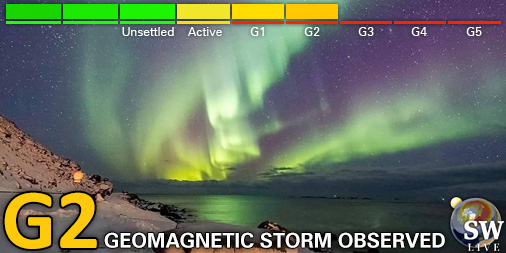Viewing archive of Thursday, 6 March 2014
Daily bulletin on solar and geomagnetic activity from the SIDC
Issued: 2014 Mar 06 1241 UTC
SIDC Forecast
Solar flares
Eruptive (C-class flares expected, probability >=50%)
Geomagnetism
Quiet (A<20 and K<4)
Solar protons
Quiet
| 10cm flux | Ap | |
|---|---|---|
| 06 Mar 2014 | 147 | 004 |
| 07 Mar 2014 | 143 | 004 |
| 08 Mar 2014 | 139 | 009 |
Bulletin
Over the last 24 hours, only 3 C-class flares have been observed, all C1. There are currently 8 sunspot regions on the visible solar disk. Most sunspot groups are stable or decaying, and have a simple magnetic configuration. Some new magnetic flux has emerged in front of NOAA 1990, and merits further monitoring. The most important CMEs that were observed were all related to backside events, including the halo CME first visible in LASCO/C2 at 13:48UT on 5 March. It was associated to a strong flare in the same region that produced another halo CME on 4 March (18:48UT). None of the observed CMEs has an Earth-directed component. Eruptive flaring conditions are expected. Solar wind speed has continued its steady increase and is now varying between 470-500 km/s, with Bz between -5nT and +5nT. The source of this moderate-speed, high-temperature, low-density stream is probably a coronal hole that passed the central meridian on 27 February. Geomagnetic conditions remained quiet. The coronal hole on the northern hemisphere that passed the central meridian early on 5 March might exert its effects starting from 8 March onwards, and may result in active geomagnetic conditions. Until then, quiet geomagnetic conditions are expected to continue.
Today's estimated international sunspot number (ISN): 087, based on 14 stations.Solar indices for 05 Mar 2014
| Wolf number Catania | 206 |
| 10cm solar flux | 149 |
| AK Chambon La Forêt | /// |
| AK Wingst | 008 |
| Estimated Ap | 008 |
| Estimated international sunspot number | 119 - Based on 23 stations |
Noticeable events summary
| Day | Begin | Max | End | Loc | Strength | OP | 10cm | Catania/NOAA | Radio burst types | |
|---|---|---|---|---|---|---|---|---|---|---|
| None | ||||||||||
Provided by the Solar Influences Data analysis Center© - SIDC - Processed by SpaceWeatherLive
All times in UTC
Current data suggests there is a slight possibility for aurora to appear at the following middle latitude regions in the near future
YakutskCurrent data suggests there is a slight possibility for aurora to appear at the following low latitude regions in the near future
Krasnoyarsk, NovosibirskLatest news
Latest forum messages
Support SpaceWeatherLive.com!
A lot of people come to SpaceWeatherLive to follow the Sun's activity or if there is aurora to be seen, but with more traffic comes higher server costs. Consider a donation if you enjoy SpaceWeatherLive so we can keep the website online!

Latest alerts
15:30 UTC - Geomagnetic activity
Minor G1 geomagnetic storm (Kp5) Threshold Reached: 15:20 UTC
14:30 UTC - Geomagnetic activity
Strong G3 geomagnetic storm (Kp7) Threshold Reached: 14:18 UTC
13:30 UTC - Geomagnetic activity
Moderate G2 geomagnetic storm (Kp6) Threshold Reached: 13:21 UTC
13:18 UTC - Hemispheric Power Index
The OVATION model predicts the Hemispheric Power Index to reach 125GW at 14:01 UTC
13:15 UTC - Geomagnetic activity
Minor G1 geomagnetic storm (Kp5) Threshold Reached: 13:13 UTC
Space weather facts
| Last X-flare | 2025/03/28 | X1.1 |
| Last M-flare | 2025/04/15 | M1.2 |
| Last geomagnetic storm | 2025/04/15 | Kp6+ (G2) |
| Spotless days | |
|---|---|
| Last spotless day | 2022/06/08 |
| Monthly mean Sunspot Number | |
|---|---|
| March 2025 | 134.2 -20.4 |
| April 2025 | 124.1 -10.1 |
| Last 30 days | 124.7 -16.6 |






